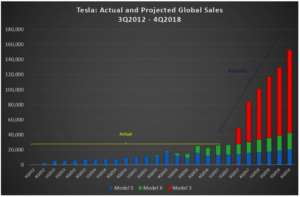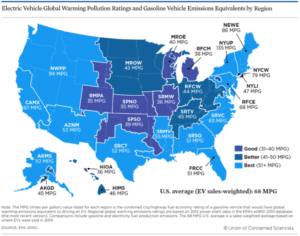Tesla’s War on “King Coal”

An introduction to Tesla's vision for and the challenges it faces on the journey towards a solar-powered civilization.
Tesla’s War on “King Coal”
“Starting a car company is idiotic and an electric car company is idiocy squared.”
-Elon Musk
In 2006, Elon Musk outlined his vision to move our global energy consumption from mine-and-burn to solar. [1] 10 years later, Musk revisited this plan, highlighting the accomplishments of the strategy to move from luxury to the average consumer, the profits of which will be used to improve accessibility for consumers around the globe through infrastructure, urban passenger vehicles, and transport trucks. [2] The challenge lies in the scale at which Tesla is producing (Figure A), its ability to move a large population away from an entrenched US power grid, and that Tesla’s operations may be outpacing its own financial capabilities.
Figure A [3]
A common misconception facing Tesla is that carbon emissions generated from a gasoline-powered vehicle are simply transferred to the electric vehicle. The 1-ton battery in a Tesla, for example, nets 17.5 tons of CO2 when produced. Further, the Tesla vehicles use rare minerals and metals that are laborious to extract. However, a Tesla Roadster is still about two times more efficient than a gasoline vehicle of comparable class yielding an effective 76 MPG. There is a tradeoff: a Tesla purchased in the United States would require anywhere from 3-6 years of driving to surpass a gasoline vehicle in net carbon emissions. [4]
How can Tesla improve this metric? Tesla and Panasonic co-built the Gigafactory – a building with the largest footprint on the planet that produces more lithium-ion batteries than every other factory in the world combined! [5] Also, the two companies built a solar cell producing facility – a solar ‘Gigafactory’ – in 2017. [2] To maximize efficiency in its plants, Tesla acquired Grohmann Engineering, a leader in automated manufacturing systems, in 2016. [6] Musk has leveraged Tesla’s SolarCity merger to push new Tesla products: the PowerWall (residential) and the PowerPack (commercial) to serve as solar-powered energy systems with the aim of cutting dependence on the US power grid. [2] The US power grid relies on 65% fossil fuels [7] and as a result, plugging a Tesla in to a home in the Midwest (power grid is more coal dependent), for example, may yield a much lower efficiency compared to gasoline-based vehicles (see Figure B) – this illuminates the fact that a one-dimensional analysis of Tesla as an ‘efficient car’ is not enough and expanding the infrastructure – the Supercharging Stations – is essential.
Figure B [4]
In a recent interview, Musk asserted that to completely take the globe off of the dirty power grid, he would require 100 gigafactories! [8] Tesla’s production aspirations are noble with the long-term goal of disrupting every aspect of the transportation industry (which contributes 25% of all carbon-based emissions). [9] However, this scale of battery production requires large sums of raw materials – perhaps the “bottleneck” of Tesla’s operations.
Cobalt, which is painstakingly extracted from the earth, is a major component in electric car batteries. 97% of cobalt production is a by-product of nickel and copper mining, and 60% of this production occurs in the Democratic Republic of Congo [10] – the per-capita income is $800, and mining production is rife with child labor and militia violence. [11] In a country with lax emissions regulations, processing Cobalt may be cheaper but it yields considerable pollution. Tesla has promised to produce 500,000 cars a year by 2018 requiring 6% of the world’s cobalt supply! Tesla has promised to source 100% of its cobalt from North America to assuage the ethical concerns in the DRC. The problem? North America currently sources 4% of the world’s cobalt and opening a new mine takes two to five years. [10, 12] Furthermore, the proliferation of battery and electric car manufacturers has skyrocketed demand for these materials – demand is expected to grow by a factor of 30 by 2030. [11] Scarcity and demand has yielded a price increase of $26,200 to $56,500 per ton of cobalt in the past year. [10] This same phenomenon is also true for lithium. [3]
Departing the reliance on African cobalt is a must. Musk will have to lobby for the expansion of mining operations in North America or the emergence of a Tesla joint venture in the mining industry, if feasible, seems in line with Elon Musk’s strategy. Fortunately, countries in Europe have already implemented legislation to ban gasoline-powered vehicles by 2040 and some by 2030 [11] but Tesla must focus on cost reduction, through their centralized plants, to increase accessibility (possibly introducing a cheaper model) to underdeveloped nations that are notorious for carbon emission production. Most notably, research into alternative batteries is essential to cut reliance on niche minerals that are in heavy demand from the tech behemoths.
Can Tesla grow as quickly as they posit considering their recent underperformance in Model 3 delivery? How can Tesla deliver given the scarcity of its raw materials? Will other car manufacturers join Tesla’s journey; what will it take?
Word Count: 800
ENDNOTES:
[1] Elon Musk, “Secret Tesla Motors Master Plan Just Between You and Me”, August 2, 2006, https://www.tesla.com/blog/secret-tesla-motors-master-plan-just-between-you-and-me, accessed November 2017.
[2] Elon Musk, “Master Plan Part Deux”, July 20, 2016, https://www.tesla.com/blog/master-plan-part-deux, accessed November 2017.
[3] Juan Carlos Zuleta, April 26, 2017, https://seekingalpha.com/article/4065523-teslas-model-3-launch-will-lithium-come, accessed November 2017.
[4] Union of Concerned Scientists. 2015, http://www.ucsusa.org/clean-vehicles/electric-vehicles/life-cycle-ev-emissions#.WgzFDRNSx-X, accessed November 2017.
[5] Elon Musk, “Tesla Unveils the Model 3”, March 31, 2016, https://www.youtube.com/watch?v=Q4VGQPk2Dl8#t=1m11s, accessed November 2017.
[6] The Tesla Team, November 8, 2016, https://www.tesla.com/blog/formation-of-tesla-advanced-automation-germany, accessed November 2017.
[7] U.S. Energy Information Administration, April 18, 2017, https://www.eia.gov/tools/faqs/faq.php?id=427&t=3, accessed November 2017.
[8] Eric Mack, October 30, 2016, https://www.forbes.com/sites/ericmack/2016/10/30/how-tesla-and-elon-musk-could-save-the-world-with-gigafactories/#7ce1442b2de8, accessed November 2017.
[9] Peter Bakker, June 29, 2016, https://www.cnbc.com/2016/06/29/beyond-tesla-solar-city-heres-what-needs-to-happen-next-to-solve-climate-change-commentary.html, accessed November 2017.
[10] John Dizard, “Lack of Ethical Cobalt Undermines Tesla Debt Issue”, August 11, 2017, https://www.ft.com/content/16436eea-7dcd-11e7-9108-edda0bcbc928, accessed November 2017.
[11] David Pilling, “Clean Electric Cars Are Built on Pollution in Congo”, July 26, 2017, https://www.ft.com/content/427b8cb0-71d7-11e7-aca6-c6bd07df1a3c, accessed November 2017.
[12] Sebastien Gandon, “No Cobalt No Tesla”, January 1, 2017, https://techcrunch.com/2017/01/01/no-cobalt-no-tesla/, accessed November 2017.





Dave Chan raises a number of good points about the feasibility of Tesla achieving its goals. Elon Musk is known to be aspirational, and has hit his targets in the past, but is this time different? The numbers on cobalt production seem to suggest it would be nearly impossible to do all that he describes.
The other interesting takeaway is that electric cars can be more or less eco-friendly depending on the location of the owner. It would be interesting to know if Tesla targets their sales efforts at areas that may have stronger environmental benefits.
Elon Musk has laid out his lofty goals, but I wouldn’t bet against him.
Mr Chen accurately points out the supply-side manufacturing hurdles Tesla must overcome to meet demand for its vehicles. Given supply constraints for cobalt, its inexperience with the politics involved in procuring commodities on so massive a scale, and price fluctuations for lithium, Tesla will struggle to meet demand for Model 3 vehicles. It is worth noting as well that Tesla has delivered at most 47,000 vehicles in any year (this year), and it would struggle to meet production demand (roughly 500,000 Model 3s) even without supply constraints.
I commend Mr Chen’s higher level argument that Tesla’s cobalt and lithium supplies are not only procurement problems but also a potential, brewing and stewing PR problem: petrol car engines take less CO2 to produce than do batteries and their motors [1], cobalt is procured in a contested area of the world and is destructive to procure, and the commitment to the Gigafactory may reduce impact but marries Tesla to li-ion technology that consumes cobalt. I have not read this insight, and it is interesting.
What Mr Chen seems to miss is the extent to which there are electric vehicle manufacturers already in play around the world. Some of these OEMs are far more successful than Tesla, or have been operating longer. Here are some: REVA (India), BYD (China), SAIC (China), BAIC (China, soon US), FAW Group (China), ProTerra (USA). Others that are coming: Lucid Motors, Faraday, etc. For these OEMs to succeed, and for new ones to enter, two critical things must happen: (1) battery prices must drop, and (2) efficient charging infrastructure must be set up.
[1] https://www.csmonitor.com/Business/In-Gear/2014/0804/Which-is-greener-Old-car-or-new-car
Matt thanks for the thorough reply. Tracking the other car companies – I think my question was more directed at the giants: GM, Chrysler, Ford. Likely, the change will require their inputs but it doesn’t seem like the incentives are quite there yet for them to shift. Perhaps they will wait for Tesla to pave the way on the raw materials and technological innovations and the “draft”?
Figure B is a fascinating representation of what the true impact is that electric vehicles have on the environment. As you outline many people think that electric is better across the board, but the amount of carbon it takes to produce the vehicles and then the electricity that those vehicles actually use is not all that “clean” in the end. I had heard about the energy it takes to create the cars and batteries in the first but hadn’t thought about how electricity is produced differently in every region.
Seems like there might be bigger things to focus as far as renewable energy goes in order to decrease carbon output (e.g. the coal power plants in the Midwest).
Tesla has clearly had ambitious targets for scale, which they have struggled to meet. The scale of raw materials needed for production seems to be a significant constraint for scaling. In order to address this, Tesla can think about working with other manufacturers that also require these raw materials to develop methods for increasing production. This would likely require these private sector players to form strategic partnerships with the governments in the relevant countries to address issues to scale such as infrastructure and labor. While this while likely be a long-term play, given the significant gap between projections and current output and the need to be a first mover in this space, Tesla likely does not have a choice.